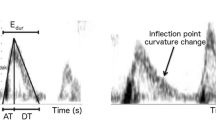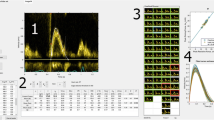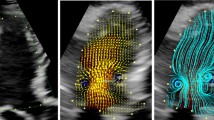Abstract
Several expressions have been considered for the diastolic pressure–volume (P–V) relation whose mechanical analogue is the force–length relation. How alternative P–V relations modify transmitral flow (Doppler E-wave) velocity contours has not been explored. The linear force–length term of a previously validated lumped parameter transmitral flow model was replaced by a logarithmic, exponential, or power law term for E-wave prediction. Model-based image processing (MBIP) was used for model-predicted flow vs. clinical E-wave comparison using root-mean-square-error (RSME) as an index of goodness-of-fit. RMSE of fits to ≈100 cm/s amplitude E-waves for linear, logarithmic, power law, and exponential relations were indistinguishable [RMSE: 4.1 ± 1.2%, 4.9 ± 1.4%, 5.1 ± 2.0%, and 5.3 ± 1.6% (mean ± SD), respectively]. We conclude that the linear force–length relation is suitable for E-wave based quantitative diastolic function assessment with the added benefit of closed form solutions to the “inverse problem” of diastole. Conversely, it is not possible to distinguish whether a ventricle obeys a linear, power law, exponential, or logarithmic P–V relation by MBIP of E-waves.
Similar content being viewed by others
REFERENCES
Appleton CP, Firstenberg MS, Garcia MJ, and Thomas JD. “The echo-Doppler evaluation of left ventricular diastolic function: A current perspective.” InKovács SJ, Ed, Card ClinNAm: Diastolic Function and Dysfunction. Philadelphia: WB Saunders 2000, pp 513–546.
Cazorla O, Freiburg A, Helmes T, McNabb M, Wu Y, Trombitás K, Labeit S, and Granzier H. Differential expression of cardiac titin isoforms and modulation of cellular stiffness. Circ Res 86: 59–67, 2000.
Cohen GI, Pietrolungo JF, Thomas JD, and Klein AL.Apractical guide to assessment of ventricular diastolic function using Doppler echocardiography. J Am Coll Cardiol 27: 1753–1760, 1996.
Courtois M, Kovács SJ, Jr, and Ludbrook PA. Transmitral pressure-flow velocity relation. Importance of regional pressure gradients in the left ventricle during diastole. Circulation 78: 661–671, 1988.
Dent CL, Bowman AW, Scott MJ, Allen JS, Lisauskas JB, Janif M, Wickline SA, and Kovács SJ. Noninvasive characterization of fundamental mechanisms of abnormal diastolic filling in diabetic rats with a parametrized diastolic filling formalism. J Am Soc Echocardiogr 14: 1166–1172, 2001.
Grossman W and Donald BS, Eds. Cardiac Catheterization, Angiography, and Intervention, 5th ed. Baltimore: Williams and Wilkins, 1996, p 324.
Hall AF and Kovács SJ. Automated method for characterization of diastolic transmitral Doppler velocity contours: Early rapid filling. Ultrasound Med Biol 20: 107–116, 1994.
Hall AF, Nudelman SP, and Kovács SJ. Beat averaging alternatives for transmitral Doppler flow velocity images. Ultrasound Med Biol 24; 7: 971–979, 1998a.
Hall AF, Nudelman SP, and Kovács SJ. Evaluation of model-based processing algorithms for averaged transmitral spectral Doppler images. Ultrasound Med Biol 24: 1; 55–66, 1998b.
Hori M, Yellin EM, and Sonnenblick EH. Left ventricular suction as a mechanism of ventricular filling. Jpn Circ J 46: 124–129, 1982.
Katz LN. The role played by the ventricular relaxation process in filling the ventricle. Am J Physiol 95: 542–553, 1930.
Kovács SJ. Diastolic filling and the equilibrium volume of the ventricle. Int Cardiovasc Med Sci 1: 109, 1997.
Kovács SJ, Barzilai B, and Pérez JE. Evaluation of diastolic function with Doppler echocardiography: The PDF formalism.AmJ Physiol 252: H178–H187, 1987.
Kovács SJ, McQueen DM, and Peskin CS. Modelling cardiac fluid dynamics and diastolic function. Phil Trans R Soc Lond A 359: 1299–1314, 2001.
Kovács SJ, Yellin E, and Meisner J. Modeling of diastole. In Kovács SJ, Ed, Card Clin N Am: Diastolic Function and Dysfunction. Philadelphia: WB Saunders, 2000, pp 459–490.
Kreyszig E. Advanced Engineering Mathematics, 6th ed. New York: Wiley, 1988, pp 1063–1067.
Lisauskas JB, Singh J, Bowman AW, and Kovács SJ. Chamber properties from transmitral flow: Prediction of average and passive left ventricular diastolic stiffness. J Appl Physiol 91: 154–162, 2001.
Little WC and Downes TR. Clinical evaluation of left ventricular diastolic performance. Prog Cardiovasc Dis 32: 273–290, 1990.
Mirsky I. Assessment of diastolic function: Suggested methods and future considerations. Circulation 69: 836–841, 1984.
Nikolic S, Yellin EL, Tamura K, Vetter H, Tamura T, Meisner JS, and Frater RWM. Passive properties of canine left ventricle: Diastolic stiffness and restoring forces. Circ Res 62: 1210–1222, 1988.
Nishimura RA and Tajik AJ. Evaluation of diastolic filling of the left ventricle in health and disease: Doppler echocardiography is the clinician's Rosetta stone. J Am Coll Cardiol 30: 8–18, 1997.
Noble D. Modeling the heart—from Genes to Cells to the Whole organ. Science 295: 1678–1682, 2002.
Rich MW, Stitziel NO, and Kovács SJ. Prognostic value of diastolic filling parameters derived using a novel image processing technique in patients ¸70 years of age with congestive heart failure. Am J Cardiol 84: 82–86, 1999.
Robinson TF, factor SM, and Sonnenblick EH. The heart as a suction pump. Sci Am 254: 84–91, 1986.
Thomas JD, Newell JB, Choong CYP, and Weyman AE. Physical and physiological determinants of transmitral velocity: Numerical analysis. Am J Physiol 260: H1718–H1731, 1991.
Yellin EL, Meisner JS, Nikolic SD, and Keren G. The scientific basis for the relations between pulsed-Doppler transmitral velocity patterns and left heart chamber properties. Echocardiography 9: 313–338, 1992.
Author information
Authors and Affiliations
Rights and permissions
About this article
Cite this article
Oommen, B.S., Karamanoglu, M. & Kovács, S.J. Can Analysis of Transmitral Flow-Velocity Contours Differentiate Between Alternative Diastolic Pressure–Volume Relations?. Cardiovascular Engineering 2, 67–72 (2002). https://doi.org/10.1023/A:1020981303354
Issue Date:
DOI: https://doi.org/10.1023/A:1020981303354




